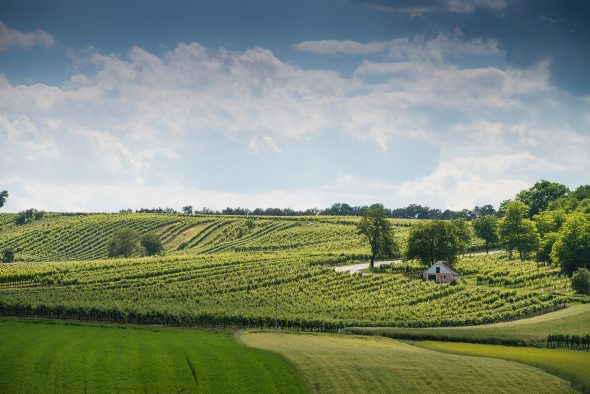A summer like in former times with enough rainfall in all parts of the huge Weinviertel helped to produce wines of classic appeal.
After the moderately wet months of winter 2019/2020, the starting soil water content for the new vintage was moderately dry. The months of pruning up until budbreak were quite warm, and precipitation was scarce until the middle/end of May. This changed in June. The vegetation, which had started very early in February, came to a standstill due to the extra-cool temperatures in May. The result was that flowering began quite late in mid-June – luckily during a few days of beautiful weather – and finished quickly without any problems. Vegetation continued at a normal pace, and hail and frost caused hardly any problems this year.
During the summer months, sunny days alternated with rainy ones. In the eastern part of Austria there were two to three times as many summer days (with temperatures above 25° Celsius) than the long-term average, and about 15 percent more hours of sunshine. Due to the frequent changes between rain and sunshine, these weeks reminded many of the “good old summers” of their childhood. More pragmatically, this meant that this traditionally very dry region did not experience any drought stress during summer 2020. The groundwater level recovered sustainably. Even the western part of the Weinviertel, with its lighter soils with lower water-holding capacity, was sufficiently supplied with water.
August 2020, typically a rather dry month according to long-term averages, was quite wet especially towards the end of the month, while temperatures stayed low. The most important task for the winemakers was to keep the grapes healthy despite an increased fungal onslaught, using targeted canopy management among other measures.
The main harvest period started as normal in mid-September with good weather conditions, was interrupted from time to time by – luckily not heavy – rainfall, and finished about four weeks later.
The 78 Million Liters of must, approx. 100.000 tons of grapes harvested is slightly lower than the long-term average. In areas with more than average yields in 2019, the yields were somehow lower in 2020 – but the reverse was also true.
Despite the slight decline in volume – equally distributed across the varieties – the winemakers of the Weinviertel are more than satisfied with the quality of the resulting wines. This year’s white and red wines are extremely well balanced, have a lively acidity and restrained alcohol levels. The constant alternation between cold and warm weather, including clear day and night differences, helped maintain acidity in the grapes, resulting in wines with a decidedly beautiful and animated fruit character, animating freshness and a well developed inner structure due to slow growth. All these factors contribute to those wines becoming long distance runners.
(Sources: *Zentralanstalt für Meteorologie und Geodynamik, ZAMG; statements from winemakers throughout the area)
Photo credits: (reprint free of charge for editorial use)
© Regional Wine Committee Weinviertel/Petr Blaha

